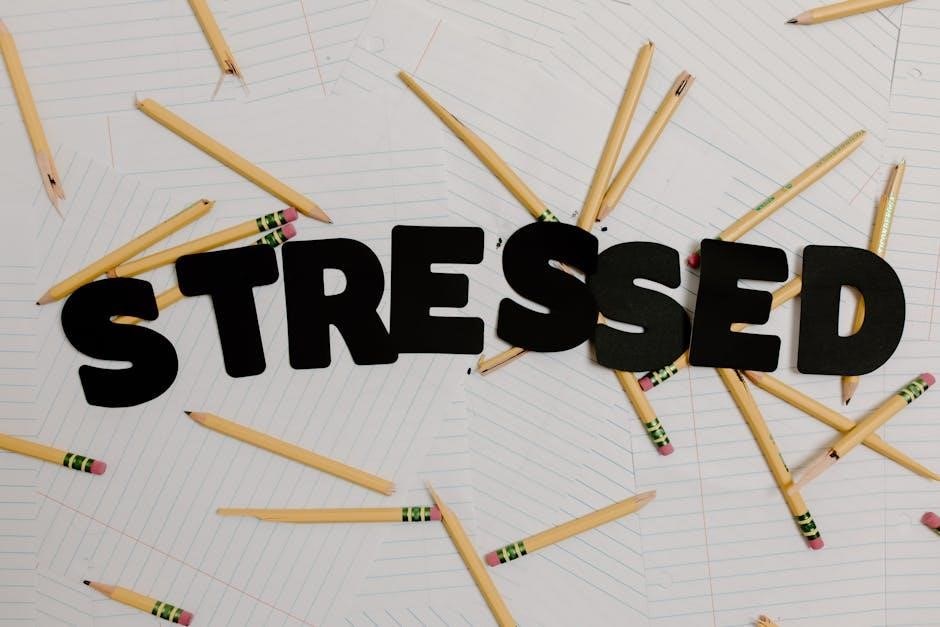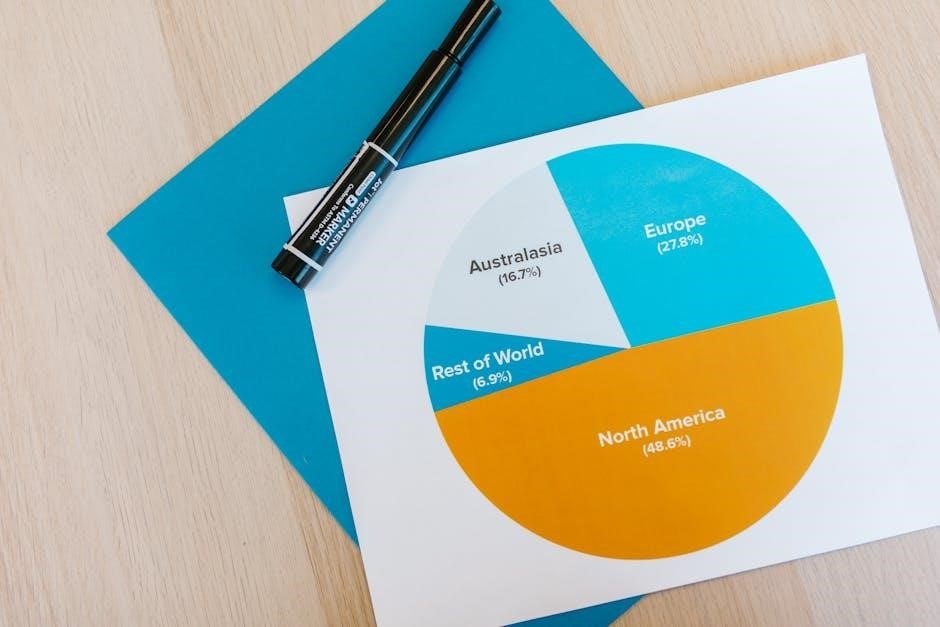Percentage word problems involve calculating parts of a whole, comparing quantities, and understanding real-world applications. They are essential for Grade 7 students to master basic math concepts and develop problem-solving skills for everyday situations.
What Are Percentage Word Problems?

Percentage word problems are mathematical exercises that involve finding, comparing, or calculating percentages in real-world scenarios. These problems typically require understanding parts of a whole, ratios, and proportions. They often involve scenarios like discounts, budgeting, or population percentages. For example, determining how much a discount saves on an item or calculating the percentage of students who scored above average on a test. These problems are presented in word form, requiring students to translate the text into mathematical equations. They are designed to assess a student’s ability to apply percentage concepts to practical situations, making them essential for developing problem-solving skills in math.
Importance of Solving Percentage Word Problems for Grade 7 Students
Solving percentage word problems is crucial for Grade 7 students as it builds foundational math skills essential for higher-level concepts. These problems enhance understanding of proportions, ratios, and real-world applications, preparing students for practical financial literacy. By mastering these skills, students improve their ability to calculate discounts, taxes, and budgets, which are vital for everyday decision-making. Additionally, percentage problems foster critical thinking and problem-solving abilities, enabling students to approach complex scenarios with confidence. Regular practice through worksheets helps reinforce these skills, ensuring students are well-prepared for future academic challenges and real-life situations that involve percentages.
Key Concepts and Skills Required
Mastering percentage word problems requires several key skills, including converting between percentages, decimals, and fractions. Students need to understand basic operations like finding a percentage of a number, calculating increases and decreases, and solving multi-step problems. The ability to interpret and set up equations based on word problem descriptions is crucial. Additionally, recognizing whether a problem involves part-to-whole or part-to-part comparisons is essential. Students should also practice identifying the unknown variable and determining whether multiplication or division is needed. Fluency in these areas ensures that students can tackle a variety of word problems with confidence and accuracy. Regular practice with worksheets helps reinforce these skills, providing a solid foundation for advanced math concepts.

Types of Percentage Word Problems
Percentage word problems include basic percent calculations, finding a percent of a number, percentage increases and decreases, and mixed operations involving multiple percentage-based calculations.
Basic Percent Word Problems
Basic percent word problems involve fundamental operations like converting percentages to decimals or fractions and vice versa. These problems often ask for a percentage of a number, such as finding 25% of 80 or determining what number is 15% of 200. They also include calculating the whole from a part, like finding the original number when 45 is 60% of it. Worksheets for Grade 7 typically include problems like “What percent of 160 is 62?” or “What number is 45% of 580?” These exercises help students understand the relationship between parts and wholes and build a solid foundation for more complex percentage problems. Regular practice with these basic problems ensures mastery of essential skills needed for real-world applications.
Percent of a Number Problems
Percent of a number problems require students to find a specific percentage of a given value. For example, “What is 25% of 80?” or “Calculate 37;5% of 240.” These problems often involve converting percentages to decimals and multiplying. Worksheets for Grade 7 students include questions like “What percent of 160 is 62?” or “What number is 45% of 580?” Solving these problems helps students understand how to apply percentages in real-life scenarios, such as calculating discounts or budget allocations. Practice with these problems enhances computational accuracy and conceptual understanding, preparing students for more complex mathematical challenges in higher grades. Regular exercises ensure fluency in percentage calculations, a crucial skill for various academic and practical applications.
Percentage Increase and Decrease Problems
Percentage increase and decrease problems involve calculating how much a number grows or diminishes by a certain percentage. These problems often appear in real-world contexts, such as price changes, budget adjustments, or population growth. For example, “A shirt originally priced at $50 is on sale for 20% off. How much will you pay?” or “A company’s profit increased by 15% last year. If the previous year’s profit was $120,000, what is the new profit?” Worksheets for Grade 7 students typically include questions that require converting percentages to decimals and applying them to calculate the new value. These exercises help students understand financial literacy, budgeting, and how percentages impact everyday decisions. Mastering these concepts is crucial for solving more complex problems in higher grades. Regular practice ensures students can apply percentage changes accurately and confidently.
Mixed Operations Involving Percentages
Mixed operations involving percentages require students to apply multiple percentage calculations in a single problem. These problems often combine percentage increase, decrease, and multiplication or division. For example, “A product’s price is first increased by 20%, then decreased by 10%. What is the final price if the original price is $50?” Such problems test students’ ability to sequence operations and understand how percentages compound. Worksheets for Grade 7 students include scenarios like successive discounts, tax calculations, and budget adjustments. These exercises enhance critical thinking and mathematical fluency. By solving mixed operations, students prepare for real-world financial decisions and more advanced math concepts. Regular practice helps build confidence and accuracy in handling multi-step percentage problems. These problems are essential for developing a strong foundation in percentage applications.

How to Solve Percentage Word Problems
To solve percentage word problems, identify the unknown and total values, convert percentages to decimals, and set up proportions or equations. Always check your answers for accuracy and ensure calculations are logical. Common mistakes include misinterpreting the base of the percentage and incorrect conversion between percentages and decimals. Practice regularly to build confidence and fluency in handling various problem types. Using worksheets and online resources can provide structured guidance and support for mastering these skills. Start with basic problems and gradually tackle more complex scenarios to reinforce understanding. Consistent practice helps develop a strong foundation in percentage calculations and real-world applications.
Step-by-Step Approach to Solving Percentage Word Problems
To solve percentage word problems, start by identifying the unknown value and the total or whole quantity. Convert percentages to decimals by dividing by 100. Set up an equation or proportion based on the problem, ensuring the percentage is applied correctly. For example, if finding a percentage of a number, multiply the number by the decimal form of the percentage. If comparing two numbers, use proportions to find the missing percentage. After solving, interpret the result in the context of the problem. Always check your work by plugging the answer back into the original problem to verify accuracy. Practicing with worksheets can help reinforce these steps and build confidence in tackling various types of percentage problems. Regular review of common mistakes, such as incorrect conversions or misinterpreting the base of the percentage, is essential for mastery.
Common Mistakes to Avoid
When solving percentage word problems, students often make errors in converting percentages to decimals or vice versa. A common mistake is misplacing the decimal, leading to incorrect calculations. Another error is misunderstanding which number represents the whole or the part, which can reverse the result. For example, in problems involving percentage increase or decrease, students might apply the percentage to the wrong original value. Additionally, some may forget to round answers appropriately or misinterpret the context of the problem. To avoid these mistakes, it’s crucial to carefully read the problem, identify the correct values, and double-check conversions. Regular practice with worksheets helps identify these errors, allowing students to improve their accuracy and understanding of percentage concepts. Consistent review of common pitfalls ensures better performance in assessments and real-world applications.
Checking Your Answers for Accuracy
Verifying your solutions to percentage word problems is essential to ensure accuracy. Start by reviewing your calculations step-by-step, checking for errors in arithmetic or percentage conversions. A helpful strategy is to convert percentages to decimals or fractions and back to confirm consistency. For example, if a problem involves finding 25% of 80, ensure that 0.25 × 80 equals 20. Additionally, estimate the reasonableness of your answer. If the problem states that 15 is what percent of 60, and your answer is 25%, verify by calculating 25% of 60, which should equal 15. Always ensure your answer makes sense in the context of the problem. Using online tools or worksheets with answers can also help confirm your solutions and improve confidence in your skills. Regularly reviewing your work builds accuracy and reduces errors over time.

Resources for Grade 7 Percentage Word Problems

Access free PDF worksheets from websites like Cuemath and Mashup Math, offering comprehensive practice materials tailored for Grade 7 students to master percentage word problems effectively.
Best Websites for Downloading Worksheets
Cuemath and Mashup Math are top choices for Grade 7 percentage word problem worksheets. Cuemath offers free PDFs with varied difficulty levels, ensuring comprehensive practice. Mashup Math provides interactive and printable materials, making learning engaging. Both sites cater to different learning styles, helping students grasp concepts like percent of a number, increase/decrease, and mixed operations. Their structured worksheets align with curriculum standards, making them ideal for teachers and parents. Regular updates and new problems keep the content fresh, supporting long-term mastery. These platforms are reliable resources for effective practice and skill development in percentage word problems.
Features of Effective Percentage Word Problem Worksheets
Effective worksheets for Grade 7 include varied problem types, such as basic percent calculations, increase/decrease scenarios, and mixed operations. They should offer clear instructions, examples, and space for calculations. Interactive elements like fill-in-the-blanks and true/false questions enhance engagement. Answer keys are essential for self-assessment. Worksheets should align with curriculum standards, ensuring relevance and comprehensiveness. Visual aids like charts and graphs help visualize concepts. Different difficulty levels cater to diverse learning paces. Regular practice with new problems supports skill retention and mastery. These features make worksheets valuable tools for developing problem-solving skills and real-world applications. They provide a structured yet flexible approach to learning percentage word problems.
Using Online Platforms for Practice
Online platforms offer a wealth of resources for practicing percentage word problems. Websites like Cuemath and Mashup Math provide free PDF worksheets tailored for Grade 7 students. These platforms often feature interactive tools, video tutorials, and step-by-step solutions to enhance understanding. They allow students to practice at their own pace, track progress, and revisit challenging problems. Some platforms include gamified exercises, making learning engaging and fun. Additionally, online resources frequently update their content, ensuring access to the latest practice materials. Utilizing these platforms complements traditional worksheets, offering a dynamic and flexible way to master percentage word problems. Regular use of these tools can significantly improve problem-solving skills and confidence.

Real-World Applications of Percentage Word Problems
Percentage word problems are used in shopping discounts, budgeting, cooking, health, and environmental conservation, helping students apply math skills to real-life scenarios effectively and confidently.
Shopping and Discounts
Shopping and discounts are common real-world applications of percentage word problems. Students learn to calculate discounts, sales tax, and price comparisons, essential for smart purchasing decisions. Worksheets often include scenarios like finding 15% off on a $50 shirt or calculating total costs with tax. These problems help students understand how percentages affect everyday expenses, making math relevant and practical. By solving such problems, Grade 7 students develop skills to manage budgets and make informed financial choices, preparing them for real-life shopping experiences and beyond.
Budgeting and Financial Literacy
Budgeting and financial literacy are critical life skills that percentage word problems help Grade 7 students develop. Worksheets often include scenarios like allocating 30% of income to savings or calculating a 10% increase in rent. These problems teach students to manage money effectively, understand budget distributions, and make informed decisions. For example, determining how much to save from a $120 allowance or calculating tax on a $50 purchase. These exercises prepare students for real-world financial responsibilities, such as creating budgets, understanding interest rates, and planning expenses. By mastering these concepts, students gain confidence in handling money and develop essential skills for long-term financial independence and stability.
Cooking and Nutrition
Cooking and nutrition often involve percentage calculations, making them practical areas for applying percentage word problems. Worksheets for Grade 7 students include scenarios like adjusting recipe ingredients by 25% or understanding nutritional information, such as 15% of the daily vitamin intake. These problems help students learn how to scale recipes up or down, calculate serving sizes, and interpret food labels. For example, determining how much sugar is in a cereal serving or figuring out the percentage of fat in a meal. These exercises not only enhance math skills but also promote healthy eating habits and practical cooking abilities. By solving these problems, students gain confidence in both the kitchen and their understanding of nutrition, making math relevant to their daily lives and future cooking endeavors.
Health and Medicine
Health and medicine provide numerous opportunities to apply percentage word problems, enhancing Grade 7 students’ understanding of real-life medical scenarios. Worksheets often include questions about medication dosages, where a 25% increase in dosage might be required, or calculating the percentage of a drug’s effectiveness in clinical trials. Students might determine the percentage of patients who experienced side effects or calculate the percentage of a daily recommended vitamin intake from a multivitamin. These problems help students grasp essential concepts like proportions and ratios while fostering an interest in healthcare. By solving such problems, students develop critical thinking skills and an appreciation for how math impacts health-related decisions, preparing them for future roles in medicine or personal health management.
Environmental Conservation
Environmental conservation often involves percentage calculations to understand and address real-world issues. Grade 7 worksheets include problems like calculating the percentage increase in recycling rates or determining the percentage of waste reduced in a community. Students might solve problems such as finding the percentage of a forest that has been replanted or the percentage reduction in carbon emissions due to new regulations. These problems help students connect math to environmental stewardship, fostering an understanding of sustainability and resource management. By solving such problems, students develop skills to analyze data and make informed decisions about conservation efforts, preparing them to contribute to a greener future.
Sports and Analytics
Sports and analytics involve using percentages to analyze performance, strategies, and outcomes. Grade 7 worksheets often include problems like calculating a player’s free throw percentage, determining the percentage of games won by a team, or finding the percentage increase in a player’s scoring average. For example, students might solve problems such as: “If a basketball player made 18 out of 25 free throws, what is their free throw percentage?” or “A soccer team won 12 out of 15 matches last season. What percent of their games did they win?” These problems help students understand how percentages are used in real-world sports analytics to evaluate performance and make data-driven decisions. Such skills are essential for understanding sports statistics and developing an interest in data analysis.
Career and Workplace Scenarios
Percentage word problems are crucial in career and workplace scenarios, where understanding percentages is essential for tasks like calculating salary increases, determining commission rates, and analyzing performance metrics. For instance, employees might need to compute a 10% raise on a $50,000 salary or determine a 15% commission on $20,000 in sales. These problems help students grasp real-world applications of percentages in professional settings. Worksheets often include scenarios like budgeting departmental expenses or evaluating profit margins, preparing students for future careers in fields like business, finance, and management. Mastering these skills enables individuals to make informed decisions and communicate effectively in the workplace. This practical knowledge bridges education and professional life, emphasizing the importance of percentage proficiency.

Assessment and Feedback
Assessment and feedback are crucial for evaluating student understanding of percentage word problems. Worksheets provide a structured way to track progress and identify areas needing improvement. Constructive feedback helps guide students toward mastery while reinforcing problem-solving skills and mathematical reasoning.
Evaluating Student Understanding
Evaluating student understanding of percentage word problems involves assessing their ability to interpret and solve real-world scenarios. Worksheets serve as a valuable tool, offering structured exercises that allow teachers to track progress and identify gaps in knowledge. By reviewing completed assignments, educators can gauge whether students grasp key concepts, such as calculating percentages of numbers, determining increases or decreases, and applying percentages to practical situations. Accurate and timely feedback is essential to guide students, helping them refine their problem-solving strategies and build confidence in their mathematical abilities. Regular assessments also enable teachers to adjust instruction, ensuring that all students reach mastery of percentage word problems by the end of Grade 7.

Using Worksheets for Formative Assessment
Worksheets are a powerful tool for formative assessment, allowing teachers to monitor student progress in real-time. By incorporating percentage word problems, educators can identify areas where students may need additional support or review. These worksheets often include a variety of problems, such as calculating discounts, budgeting, or determining percentage increases and decreases. Regular use of these resources helps teachers adjust their instruction to address common misconceptions and ensure students are on track to meet learning goals. Additionally, worksheets provide students with the opportunity to practice and reinforce their skills, building confidence and fluency in solving percentage-related problems. This ongoing assessment loop supports both teaching and learning, fostering a more effective educational environment for Grade 7 students.

Providing Constructive Feedback
Constructive feedback is crucial for helping students improve their understanding of percentage word problems; Teachers should provide specific comments that highlight strengths and areas for improvement. For example, if a student correctly calculates a discount but struggles with interpreting the result, feedback might focus on enhancing their ability to apply the percentage in real-world contexts. Positive reinforcement for correct answers can boost confidence, while suggestions for improvement guide students toward better problem-solving strategies. Regular feedback sessions, supported by worksheets, help students track their progress and stay motivated. Tailoring feedback to individual needs ensures that each student receives targeted guidance, fostering a deeper understanding of percentage concepts and their practical applications. This approach creates a supportive learning environment where students feel encouraged to ask questions and seek clarification.
Mastering percentage word problems is essential for Grade 7 students. Worksheets offer practical experience, enhancing problem-solving skills and real-world application abilities, supported by resources like Cuemath.
Percentage word problems are essential for developing mathematical proficiency in Grade 7 students. These problems help students understand real-world applications, such as shopping discounts, budgeting, and health-related calculations. Worksheets like those from Cuemath and Mashup Math provide structured practice, ensuring students grasp concepts like calculating percentages of numbers, determining unknowns, and understanding increases or decreases. Regular practice with these resources builds confidence and fluency. Key skills include interpreting percentages, setting up equations, and applying proportions. Additionally, worksheets often include mixed operations, reinforcing multi-step problem-solving. By mastering these skills, students can apply mathematical reasoning to various scenarios, making informed decisions in daily life.
- Understand percentages in real-world contexts.
- Practice with worksheets for skill mastery.
- Apply math to solve practical problems.
- Develop problem-solving and critical thinking.
Encouraging Further Practice and Mastery
Consistent practice is crucial for mastering percentage word problems. Utilize resources like Cuemath and Mashup Math, which offer free PDF worksheets tailored for Grade 7 students. These materials cover various problem types, from basic calculations to real-world applications. Additionally, incorporate online platforms that provide interactive exercises and quizzes to make learning more engaging. Forming study groups or joining online communities can also foster a supportive environment for shared learning. Encourage students to review their mistakes and understand where they went wrong, promoting a deeper understanding of the concepts. By combining structured practice with interactive learning tools, students can confidently enhance their skills and achieve mastery in percentage word problems.
- Use Cuemath and Mashup Math for practice worksheets.
- Engage with online platforms for interactive exercises.
- Form study groups for collaborative learning.
- Review and understand errors to improve.




Leave a Reply
You must be logged in to post a comment.